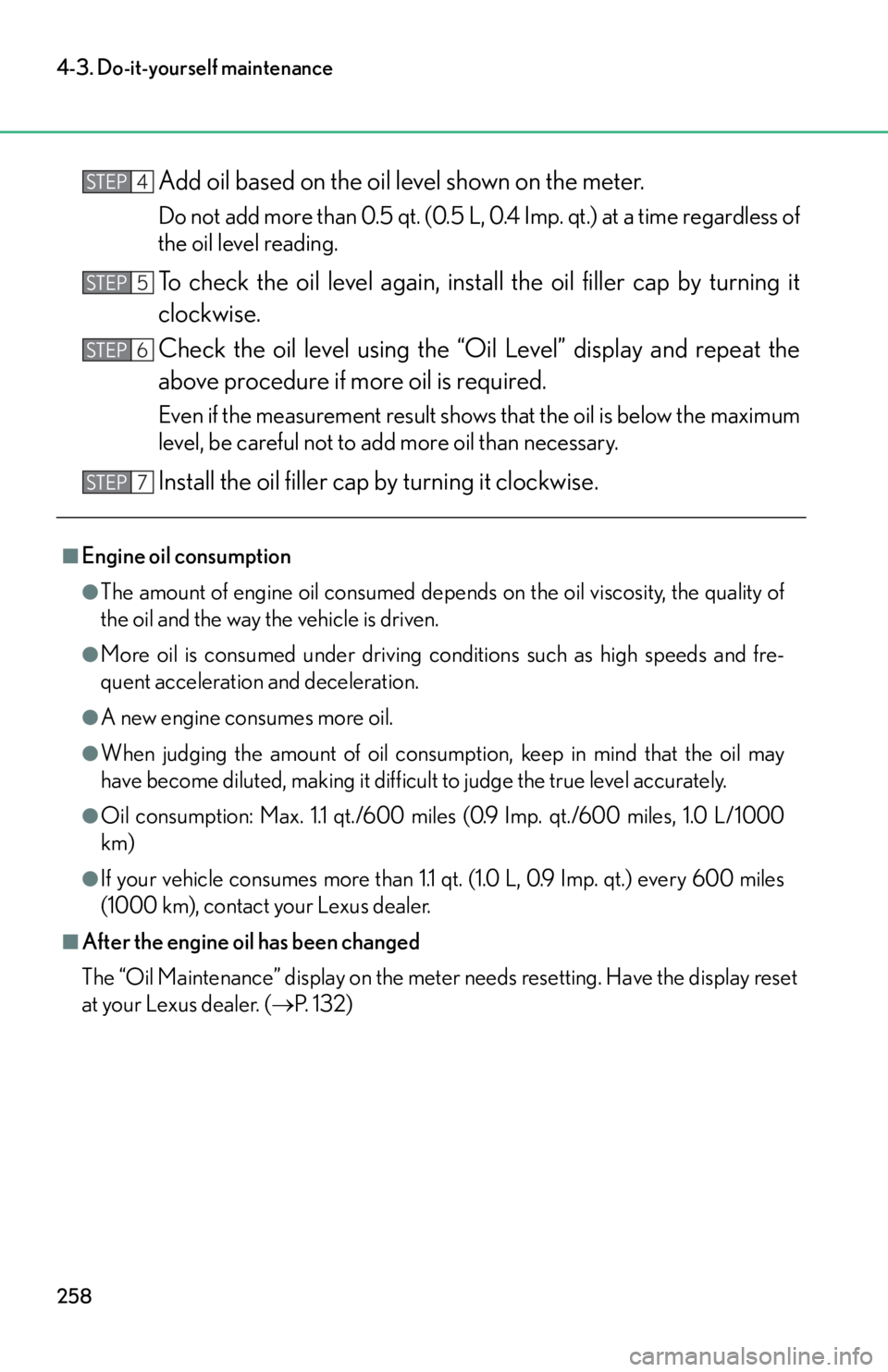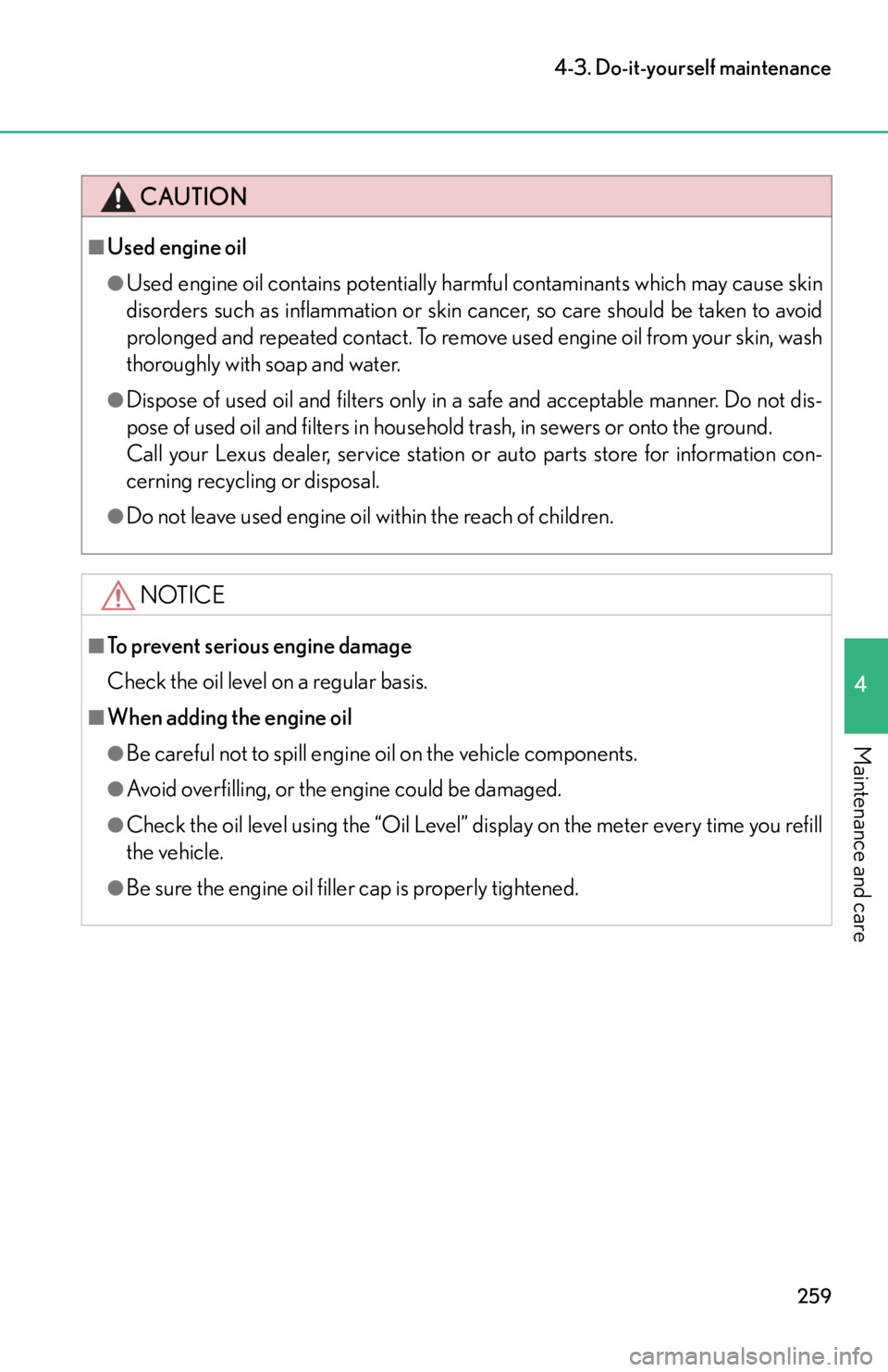Page 260 of 420

258
4-3. Do-it-yourself maintenance
Add oil based on the oil level shown on the meter.
Do not add more than 0.5 qt. (0.5 L, 0.4 Imp. qt.) at a time regardless of
the oil level reading.
To check the oil level again, install the oil filler cap by turning it
clockwise.
Check the oil level using the “Oil Level” display and repeat the
above procedure if more oil is required.
Even if the measurement result shows that the oil is below the maximum
level, be careful not to add more oil than necessary.
Install the oil filler cap by turning it clockwise.
■Engine oil consumption
●The amount of engine oil consumed depe nds on the oil viscosity, the quality of
the oil and the way the vehicle is driven.
●More oil is consumed under driving conditions such as high speeds and fre-
quent acceleration and deceleration.
●A new engine consumes more oil.
●When judging the amount of oil consumpt ion, keep in mind that the oil may
have become diluted, making it difficult to judge the true level accurately.
●Oil consumption: Max. 1.1 qt./600 miles (0.9 Imp. qt./600 miles, 1.0 L/1000
km)
●If your vehicle consumes more than 1.1 qt. (1.0 L, 0.9 Imp. qt.) every 600 miles
(1000 km), contact your Lexus dealer.
■After the engine oil has been changed
The “Oil Maintenance” display on the mete r needs resetting. Have the display reset
at your Lexus dealer. ( P. 1 3 2 )
STEP4
STEP5
STEP6
STEP7
Page 261 of 420

259
4-3. Do-it-yourself maintenance
4
Maintenance and care
CAUTION
■Used engine oil
●Used engine oil contains potentially harmful contaminants which may cause skin
disorders such as inflammation or skin cancer, so care should be taken to avoid
prolonged and repeated contact. To remove used engine oil from your skin, wash
thoroughly with soap and water.
●Dispose of used oil and filters only in a safe and acceptable manner. Do not dis-
pose of used oil and filters in househol d trash, in sewers or onto the ground.
Call your Lexus dealer, service station or auto parts store for information con-
cerning recycling or disposal.
●Do not leave used engine oil within the reach of children.
NOTICE
■To prevent serious engine damage
Check the oil level on a regular basis.
■When adding the engine oil
●Be careful not to spill engine oil on the vehicle components.
●Avoid overfilling, or the engine could be damaged.
●Check the oil level using the “Oil Level” display on the meter every time you refill
the vehicle.
●Be sure the engine oil filler cap is properly tightened.
Page 262 of 420
260
4-3. Do-it-yourself maintenance
Engine coolantThe coolant level is satisfactory if it is between the “FULL” and “LOW”
lines on the reservoir when the engine is cold.
“LOW”
If the level is on or below the
“LOW” line, add coolant up to the
“FULL” line.
“FULL”
Reservoir cap
■Coolant selection
Only use “Toyota Super Long Life Coolant” or a similar high quality ethylene glycol
based non-silicate, non-amine, non-nitrite, and non-borate coolant with long-life
hybrid organic acid technology.
“Toyota Super Long Life Coolant” is a mixture of 50% coolant and 50% deionized
water. (Minimum temperature: -31 F [-35C])
For more details about coolant, contact your Lexus dealer.
■If the coolant level drops within a short time of replenishing
Visually check the hoses and engine coolant reservoir cap.
If you cannot find a leak, have your Lexus dealer test the cap and check for leaks in
the cooling system.
Page 263 of 420
261
4-3. Do-it-yourself maintenance
4
Maintenance and care
CondenserCheck the condenser and clear any foreign objects.
If it is extremely dirty or you are not sure of its condition, have your vehicle
checked by your Lexus dealer.
CAUTION
■When the engine is hot
Do not remove the engine coolant reservoir cap.
The cooling system may be under pressure and may spray hot coolant if the cap is
removed, causing burns or other injuries.
NOTICE
■When adding engine coolant
Coolant is neither plain water nor straight antifreeze. The correct mixture of water
and antifreeze must be used to provide proper lubrication, corrosion protection
and cooling. Be sure to read the antifreeze or coolant label.
■If you spill coolant
Be sure to wash it off with water to prevent it from damaging parts or paint.
CAUTION
■When the engine is hot
Do not touch the condenser, as it may be hot and cause burns.
Page 264 of 420
262
4-3. Do-it-yourself maintenance
Brake fluid■ Checking fluid level
The brake fluid level should be
between the “MAX” and “MIN”
lines on the tank.
■ Adding fluid
Make sure to check the fluid type and prepare the necessary item.
Fluid type FMVSS No.116 DOT 3 or SAE J1703 brake fluid
ItemClean funnel
■Brake fluid can absorb moisture from the air
Excess moisture in the brake fluid can cause a dangerous loss of braking efficiency.
Use only newly opened brake fluid.
CAUTION
■When filling the reservoir
Take care as brake fluid can harm your hands and eyes and damage painted sur-
faces.
If fluid gets on your hands or in your eyes, flush the affected area with clean water
immediately.
If you still experience discomfort, see a doctor.
Page 265 of 420
263
4-3. Do-it-yourself maintenance
4
Maintenance and care
NOTICE
■If the fluid level is low or high
It is normal for the brake fluid level to go down slightly as the brake pads wear out or
when the fluid level in the accumulator is high.
If the reservoir needs frequent refilling, there may be a serious problem.
Page 266 of 420
264
4-3. Do-it-yourself maintenance
Adding washer fluid
If any washer does not work or the warning message appears on the meter,
the washer tank may be empty. Add washer fluid.
Open the fuel filler door. (P. 4 9 )
Open the cap.STEP1
STEP2
NOTICE
■Do not use any fluid other than washer fluid
Do not use soapy water or engine antifreeze instead of washer fluid.
Doing so may cause streaking on the vehicle’s painted surfaces.
■Diluting washer fluid
Dilute washer fluid with water as necessary.
Refer to the freezing temperatures listed on the washer fluid container.
Page 267 of 420
265
4-3. Do-it-yourself maintenance
4
Maintenance and care
Battery
The battery is located on the left-hand side of the luggage compartment.
Open the rear hatch and remove
the cover.
Make sure that the battery term inals are not corroded and that
there are no loose connections, cracks or loose clamps.
Terminals
Hold-down clamp
Ground cableSTEP1
STEP2